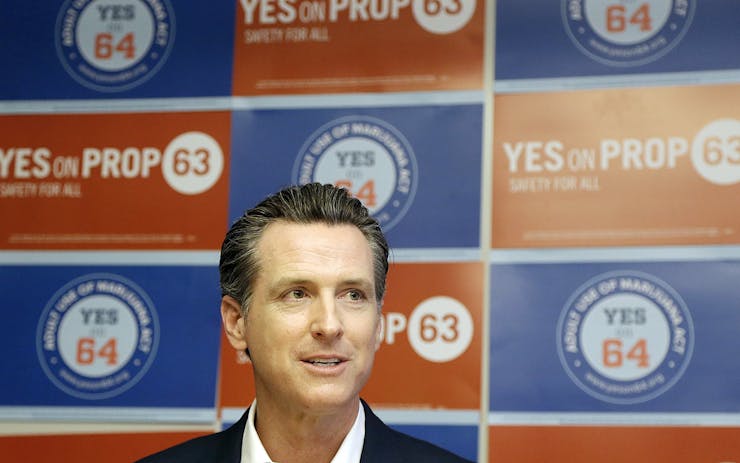SAN FRANCISCO — To say the scene at California Lt. Gov. Gavin Newsom’s Proposition 64 victory party was surreal is something of an understatement. The event, held at the upscale San Francisco nightclub Verso had been billed as a double-shot celebration for both Prop. 64 and a sister ballot initiative for gun control, but the mood inside was almost schizophrenic.
The club was packed with reporters and TV crews, and a nicely dressed, youngish crowd of supporters who had come expecting to applaud an important step in social justice (and the youthful, nicely dressed lieutenant governor who made the issue a personal battle). But the party was muted. Walking in, you immediately felt a division of attention by the crowd—torn between Newsom, who stood in the center of the floor, and the three massive plasma TV screens, on which the national election returns were playing.
Newsom seemed undeterred. The former mayor of San Francisco, who made a national name for himself championing marriage equality before moving on to cannabis, stood there, giving one interview after another to TV stations, radio reporters, newspaper reporters. Most seemed to be asking a variation of the same question, essentially: How did Prop. 64 do so much better than its 2010 predecessor, Prop. 19, which presented voters with roughly the same choice but failed miserably, with a 53.5 percent no vote?
Newsom, who is tall and angular, articulate, and, apparently, inexhaustible, responded to each with a quick succinct summary that he’s probably given hundreds of times over the past two years. “We had a political coalition and that was broader and deeper,” he said. “We had more political courage, political leaders willing to step up and take this on. We had the examples of Washington and Colorado, Oregon and Alaska. Those things, combined with the general sense that prohibition has failed us, made it possible this time.”
Preparation, he said, was key. “We spent two years putting together a coalition. We put out 50 policy recommendations. We spent two years having a sustainable public conversation about this.”

(Paul Roberts for Leafly)
Newsom and his colleagues were, of course, also aided by a culture that’s shifted its views on cannabis over the last six years. Support among state voters for legalization has grown by around 5 percent, according to the Public Policy Institute of California. Part of that reflects the ongoing national evolution in cannabis attitudes, but it reflects just as clearly the steady efforts by Newsom and other legalization advocates in California.
Pro-64 groups raised more than $22 million in campaign funds, more than 10 times the amount raised by opponents. Just as important, Prop. 64 advocates targeted many of the demographic and political obstacles that had derailed Prop. 19.
The fact is that voters here were hugely divided on the issue, demographically and regionally. For example, while Prop. 19 had polled extremely well in the more liberal, northern part of the state, especially in San Francisco, San Marin, and Santa Cruz counties, it did poorly across the more conservative, southern half of the state. Indeed, some polls showed that, overall, California voters were actually less supportive of adult-use cannabis in 2010 than were Americans as a whole.
“There's going to be a lot of whitewater as we move from something old to something new.”
Thus, supporters of Prop. 64 worked hard to broaden the cannabis coalition. They worked not only to build support among Latinos and Republicans, for example, but also to mend regional fences by forging political connections between northern and southern California lawmakers.
In the Los Angeles area, proponents decided to focus on reaching out to the region’s black and Latino communities—voting blocs that polls showed would be a tough sell and those thought to be less likely to see ads supporting the measure, said Cat Packer, who coordinated LA outreach efforts. One worry, was that the “Trump factor” would bring out Latino voters in force—something the campaign feared could hurt the measure’s chances, Packer said. “Minorities were the most reluctant because they have been criminalized for so long.”
Shop highly rated dispensaries near you
Showing you dispensaries nearCritically, the campaign also worked hard to replace cannabis’ stoner image with more mainstream faces. Taking a page from the LGBT playbook, advocates encouraged medical cannabis patients to “come out” with personal testimonials about cannabis’s benefits, so that “the cannabis user was no longer the scary drug dealer on the corner—it’s your sister,” said Dale Sky Jones, the chancellor of Oaksterdam University in Oakland and a former head of California Reform. “We really changed the nature of the conversation.”
The work paid off. Prop. 64 gained big-name sponsors as well as and endorsements from every major big-city daily newspaper except the Sacramento Bee. Advocates also saw major attitude shifts in key demographics, including Republican voters (among whom support rose by 10 points, according to the Public Policy Institute of California) and Latinos (who increased support by 5 points).
Newsom, who is widely seen as the frontrunner in California’s 2018 race for governor, was careful not to disrespect the efforts of Prop. 19. To the contrary, he readily acknowledged that Prop. 64’s success couldn’t have happened without earlier advocacy efforts in the state. “Without Proposition 19, there would have been no [legalization in] Washington, there have been no Colorado, we wouldn’t be where we are tonight,” he said. “What they did inspired what we did, and I tip my hat to them, but frankly this was a much better law. It addresses workplace protections, it addresses safety for children and families, and it does it in a more thoughtful, comprehensive way.”
As important, like other cannabis advocates, Newsom is quick to point out that the real work has only just begun. Advocates, industry players, and government officials, he says, are now faced with the task of implementing this hugely complicated new law—and trying to avoid some of the problems that frustrated similar efforts in other states.
“It’s going to be very difficult ” Newsom acknowledged. “There’s going to be a lot of whitewater as we move from something old to something new.”
Among many issues, Newsom said, the state must move quickly and issue temporary licenses that will serve until the law can be fully implemented. That’s key, he says, because although it’s now technically legal to possess recreational caannibis, it’s still illegal to sell it.
A bigger issue, Newsom conceded, is trying to avoid the pushback by local city and county governments that may be skeptical or downright hostile to legalization. Many local governments have already enacted pre-emptive bans and restrictions. But Newsom believes this may be a temporary phase as skeptics try to assess the impacts of the law. “I think what we’re going to see here are a lot of cities and counties that say no initially and then say yes. ”
He noted, for example, that one of the state’s biggest cities, San Jose, passed a preemptive ordinance against cannabis business—but that this is likely temporary while city officials observe how the law plays out in other cities. “I think they’re just going to wait and see.”
But again and again he made the point that the process is only just beginning. “We have a lot of work to do, and that’s why I’ve always made the point that legalization is not something that happens overnight, it’s a process [that will] unfold over a number of years.”
He sees 2017 an interim period, he said. “Basically, we’ve got a year to get this right, and we do want to make sure we get it right.”
It was hard not to catch Newsom’s infectious optimism, yet the evening’s mood grew somber as the national election’s results raised questions the future of legal cannabis. Although 4 of 5 states passed adult-use legalization initiatives last night, the situation at the federal level, attendees said, remains uncertain.
As the event wound down and the remaining partygoers stood watching the election returns on TV, John Maa, chair of the tobacco-related disease research program at the University of California, made a dour observation. “The primary reason that recreational use in Washington, Colorado, Oregon, and Alaska hasn’t been shut down by the federal government is that the Obama administration has chosen to look the other way. But,” Maa said, glancing at a shot of Trump’s face on a giant screen, “what happens with him?”
Lead Image: Jeff Chiu/AP
Chase Scheinbaum contributed to this report from Los Angeles.




